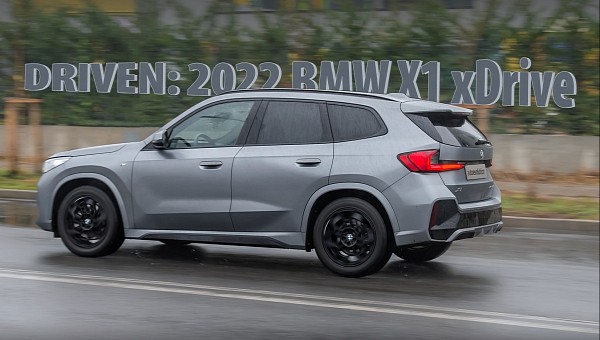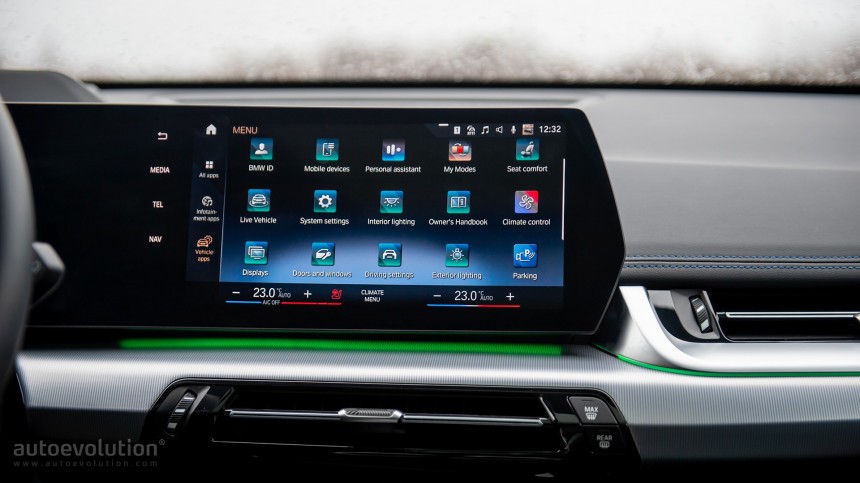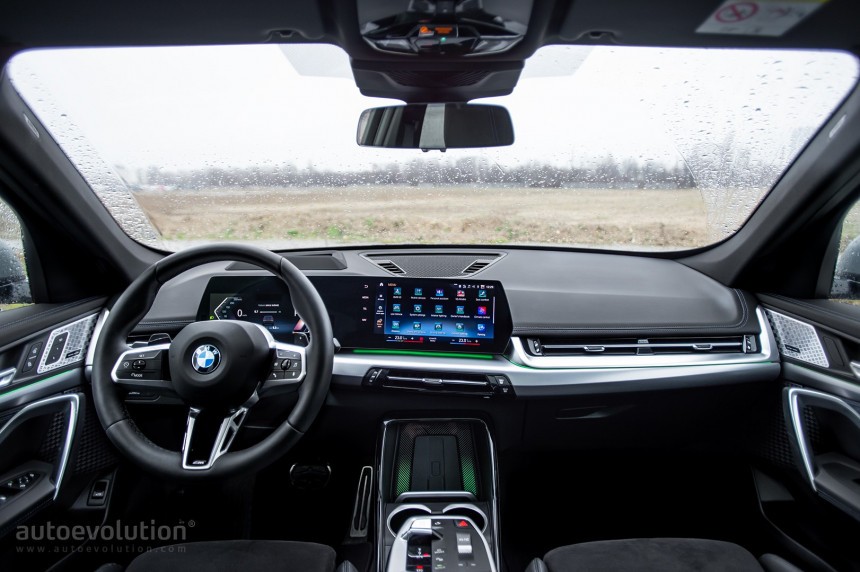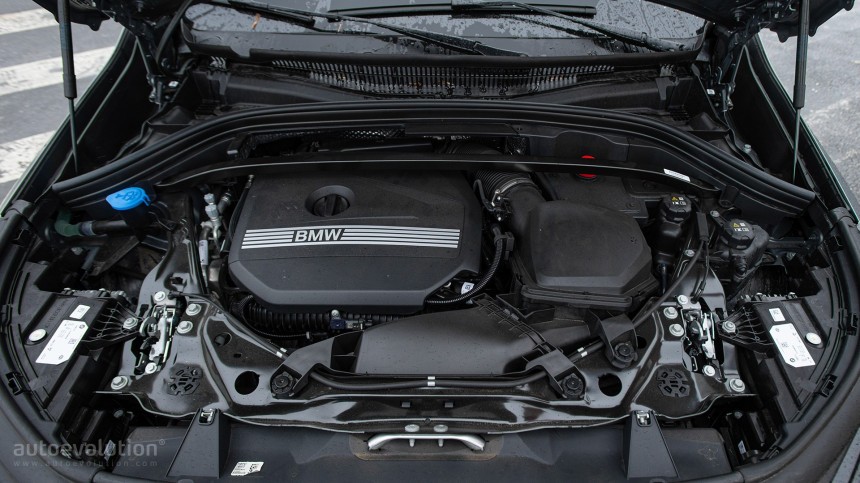Driven: 2023 BMW X1 xDrive 23i: Coming of Age
Bigger, more powerful, and smarter, the third generation of the BMW X1 claims to be much more than an entry-level within the BMW SAV range. We have tested the all-wheel drive turbocharged gasoline X1 xDrive 23i version, and this is how it went down.
BMW never had this compact SUV in plan. The decision to produce this model came at the request of BMW's trade unions, who wanted a cheaper, more versatile, and more compact vehicle than the X3. BMW management fancied the idea, and in 2009, the first generation X1 was launched, based on the rear-wheel drive platform of the 3 Series Touring. This is why it is widely regarded as the only true X1.
In 2016, the second generation was released, carrying over the UKL front-wheel drive architecture used both in the MINI range and the second generation of the BMW 1 Series. The pleasure of driving associated with the Bavarian brand was partly lost and, in addition, the X1 did not include all the technological features available on larger BMW models. As a result, the German manufacturer is now taking a different approach, and although the third generation is also based on the advanced front-wheel drive architecture, the UKL2, it enjoys all the modern technologies now available at BMW.
Moreover, if you opt for the M Sport package, which the test car featured (for an additional €2,125, with the xLine option also available for €462 – this would amount to approximately $2,300 and $500 at the current exchange rates), you get large cooling air inlets on the outer sides of the front bumper and a striking rear apron with integral diffuser element, inducing a touch of aggressiveness and sportiness which goes hand in hand with the quite massive grille. At the rear, the X1 picks up the L-shaped taillights typical of all the models released by the Bavarian brand in recent times. Inside, the M Sport package comes with sports seats, an M steering wheel upholstered in leather, shift paddles, and an anthracite-colored headliner.
At first sight, the two screens leaning towards the driver, a 10.25-inch one showing the instrument panel, and a 10.7-inch screen for the infotainment system, hidden under a frameless glass window, look astonishing. The HVAC control panel with physical buttons is gone, as it's now included in the multimedia menu. For easier access, the climate control menu is always located at the bottom of the center display, regardless of which menu is displayed on the screen. That is why it is easy to access, but not as easy to operate through its submenus – for example, modifying the air recirculation requires you to enter a submenu. Or there's no longer a direct button for heating the seats, which prompts you to access the AC menu.
Then, there are so many menus, that you basically end up getting lost. For example, who would have thought that the fuel consumption can be found in the “live vehicle” menu? For instance, I spent several minutes trying to figure out how to disable lane assist and still could not find it. Fortunately, BMW are, too, aware that the menus are very complicated, and they've added a search function similar to that of a text document on a laptop. You enter the "browse menu", search for "lane assistant", and are redirected to the respective submenu, which allows you to turn the option on or off.
Of course, you can also operate the multimedia system by using the keys on the right spoke of the steering wheel or by voice control. For example, the BMW Intelligent Personal Assistant allows you to adjust the air conditioning via voice control, as well as open a window or the optional panoramic sunroof, use Siri Assistant, Google Assistant, streaming services, or the WhatsApp messaging app. In addition, the new color head-up display provides much more information. The excellent 360-degree camera is also worth mentioning, as the top view it provides comes in very handy for parking in tight spaces and not only.
The new X1 is smarter not just in terms of communication, but also when it comes to storage space. At the bottom of the dashboard, it features a wireless phone charging compartment where the device is placed in an upright position, secured with a flap so that it doesn't move, ensuring complete visibility of the display. Surprisingly for a BMW, all four doors are equipped with storage areas that allow placing a 1.5-liter bottle each. In front of the phone compartment, there is a cup holder, as well as two USB-C ports, while two more can be found in the vicinity of the rear seats.
As with any modern BMW, the rear bench seat is split-folding in a 40/20/40% ratio, and by completely lowering it, you get a flat loading surface. As an option, the rear seat segments can slide 13 cm (5.1 inches), resulting in more knee or trunk room. With the rear seat in the upright position, the luggage compartment has a volume of 500 liters (30.511 in), which can be extended up to 1,545 liters (94.037 in). Although several competing models offer a bit more than that, these are still decent values. The backrest of the rear bench is very well-shaped, offering great comfort for two persons during long-distance travels. However, knee room is only sufficient, and not generous, although the architecture with the transversally-mounted engine had us expecting it to be more spacious. Anyone who wants more space would be better off opting for an X3.
The xDrive23i's two-liter turbo engine is part of the new BMW modular engine family, operates in the Miller cycle (shortening the opening time of the intake valves), and features redesigned intake manifold and combustion chamber, as well as a dual injection system. Moreover, although it is a mild hybrid, BMW have increased the Li-Ion battery's capacity to 0.96 kWh, in order to provide more power to the starter generator. Actually, on braking, up to 15 kW of energy is recovered, subsequently being used during acceleration phases.
As a result, during eco-driving, fuel consumption can drop below 7 liters (33.6 mpg) per 100 km (62 miles), whereas for normal driving, the consumption varies between 8.5 liters (27.7 mpg) and 9 liters (26.14 mpg) per 100 km (62 miles). These are very good values for an SUV weighing over 1,700 kg (3,748 pounds). On the other hand, the larger battery takes away 40 more liters (2.441 in) from the trunk room.
BMW has introduced a new feature called Sport Boost. It can be activated for 10 seconds by pressing the left paddle, and, when this happens, the engine's 204 ps (201 hp) receive additional support from the 19 ps (18.7 hp) provided by the starter generator. The extra oomph is automatically available anyway, at startup and, in theory, also at stronger accelerations.
Like other BMW SUVs, the BMW X1 drives incisively and appealingly. The steering is precise and quite short, but a little soft around the dead center. By using the M Sport package, which comes with an adaptive sports suspension, lowered by 15 mm (0.59 inches), the roll is reduced; however, the test car was equipped with General Grabber AT winter tires (!), which affected the handling. They lose grip quite quickly on wet roads, but offer increased grip during off-road scenarios. Nonetheless, we cannot help but wonder why anyone would take a BMW SUV with M Sport suspension on an off-road trail anyway. A few weeks ago, we also drove the xDrive23d diesel version equipped with summer tires, and it had a higher grip.
Under normal circumstances, the X1 xDrive 23i only pulls with the front axle only and, if necessary, the electrohydraulic clutch of the all-wheel drive system sends up to 50% of the torque to the rear axle. Pushed to the limit, the X1 is mild-understeered, but, due to the General Grabber tires fitted on the car, it understeered earlier, which made it harder to control on wet surface.
On the other hand, this time around, BMW did not cut on the materials’ qualities anymore. The X1 no longer feels like a poor cousin of the X3. It features far fewer hard plastic surfaces, and the Sensatec leather-clad dashboard, the aluminum mesh imitation insert on the dashboard, as well as the seats upholstered in a mix of Alcantara and leather contribute to the premium look that lives up to what is expected from a BMW.
But driving comfort does not meet the class standards. The mix between the M Sport suspension, even with adaptive function, and the AT General Grabber tires killed the comfort off. Rear-seated passengers, in particular, cannot experience comfort during long-distance travels, due to the rear axle vertical accelerations, which are way too high and end up catapulting occupants upwards in a Merry-Go-Round style with any short bump encountered. That is why we recommend – especially for American states where asphalt is not so good – opting for the standard suspension version, which offers more comfort. It is true that, with the deletion of the M Sport package, some of the features are lost, but you can find them in the Premium (€3,877 or $4,200) and Active Distance Assistant Pro (€1,570 or $1,700) packages. Alternatively, you can simply drop the sports suspension provided by the M Sport package, and save up on its €462 ($500) cost.
Otherwise, the two-liter engine is extremely quiet and sophisticated. Faster acceleration comes with a typical pleasant-toned BMW sound, while the vigorous torque is truly impressive at medium speeds, which is partly due to the support provided by the starter generator integrated into the automatic gearbox. The seven-speed dual-clutch automatic gearbox allows for changing gears smoothly and without the shocks typical of other such transmissions. In addition, it makes for an enjoyable use in the city, while it doesn't show any sign of hesitation during starting and driving in Eco mode. Besides, the seven-speed dual-clutch automatic gearbox is standard across the range.
The X1 xDrive23i's drivetrain delivers great performance, high refinement, and more than decent fuel efficiency. The interior is modern and high-tech, but the OS8 operating system is complicated and requires a longer time to comprehend. Furthermore, the interior room is decent, but not generous, and ride comfort can be good if you opt out of the M Sport package. As for the price, in Europe, the car is quite expensive, because paying around €50,000 ($54,330) for a compact SUV, even if it is of premium quality, is too much.
PROS
CONS
In 2016, the second generation was released, carrying over the UKL front-wheel drive architecture used both in the MINI range and the second generation of the BMW 1 Series. The pleasure of driving associated with the Bavarian brand was partly lost and, in addition, the X1 did not include all the technological features available on larger BMW models. As a result, the German manufacturer is now taking a different approach, and although the third generation is also based on the advanced front-wheel drive architecture, the UKL2, it enjoys all the modern technologies now available at BMW.
Design evaluation
With a length of 4,500 mm (177 inches), the X1 is almost as large as the first-generation X3 (E83). From the outside, the compact SUV is extremely robust, with a higher hood and a more vertical front, dominated by a massive radiator grille. Although lately BMW has gone over the top when it comes to the dimensions of the kidney grille (see, for example, the new BMW 7 Series), in the case of the X1, this part’s proportions are decent, leading to a more commanding presence on the road.Moreover, if you opt for the M Sport package, which the test car featured (for an additional €2,125, with the xLine option also available for €462 – this would amount to approximately $2,300 and $500 at the current exchange rates), you get large cooling air inlets on the outer sides of the front bumper and a striking rear apron with integral diffuser element, inducing a touch of aggressiveness and sportiness which goes hand in hand with the quite massive grille. At the rear, the X1 picks up the L-shaped taillights typical of all the models released by the Bavarian brand in recent times. Inside, the M Sport package comes with sports seats, an M steering wheel upholstered in leather, shift paddles, and an anthracite-colored headliner.
Interior assessment
Earlier on, I mentioned that the X1 no longer wants to be the poor relative of BMW's SAVs. Whereas, for the second generation, digital instrument cluster could not be ordered, the new X1 now features the most modern BMW operating system, the OS8, introduced with the iX. Briefly put, that means a plethora of applications and permanent internet connection, while the isolated controller and HVAC panel are long gone. Is this a good or a bad thing?Then, there are so many menus, that you basically end up getting lost. For example, who would have thought that the fuel consumption can be found in the “live vehicle” menu? For instance, I spent several minutes trying to figure out how to disable lane assist and still could not find it. Fortunately, BMW are, too, aware that the menus are very complicated, and they've added a search function similar to that of a text document on a laptop. You enter the "browse menu", search for "lane assistant", and are redirected to the respective submenu, which allows you to turn the option on or off.
Of course, you can also operate the multimedia system by using the keys on the right spoke of the steering wheel or by voice control. For example, the BMW Intelligent Personal Assistant allows you to adjust the air conditioning via voice control, as well as open a window or the optional panoramic sunroof, use Siri Assistant, Google Assistant, streaming services, or the WhatsApp messaging app. In addition, the new color head-up display provides much more information. The excellent 360-degree camera is also worth mentioning, as the top view it provides comes in very handy for parking in tight spaces and not only.
The new X1 is smarter not just in terms of communication, but also when it comes to storage space. At the bottom of the dashboard, it features a wireless phone charging compartment where the device is placed in an upright position, secured with a flap so that it doesn't move, ensuring complete visibility of the display. Surprisingly for a BMW, all four doors are equipped with storage areas that allow placing a 1.5-liter bottle each. In front of the phone compartment, there is a cup holder, as well as two USB-C ports, while two more can be found in the vicinity of the rear seats.
Driving take
The version we tested was the xDrive 23i equipped with the 204 ps (201 hp) 2-liter turbo engine and 48V mild hybrid technology with integrated generator starter that develops 19 additional ps (18.7 hp), resulting in a total of 218 ps (215 hp). In the U.S., there is only one version currently on the market, the X1 xDrive 28i with 241 hp. Europeans are more privileged, as they can opt for almost all types of propulsion: two PHEV versions, three diesel versions out of which two feature 48V mild hybrid technology, three petrol-powered versions of which two also feature 48V mild hybrid, and an electric iX1 version. A sporty X1 M35i version will follow.The xDrive23i's two-liter turbo engine is part of the new BMW modular engine family, operates in the Miller cycle (shortening the opening time of the intake valves), and features redesigned intake manifold and combustion chamber, as well as a dual injection system. Moreover, although it is a mild hybrid, BMW have increased the Li-Ion battery's capacity to 0.96 kWh, in order to provide more power to the starter generator. Actually, on braking, up to 15 kW of energy is recovered, subsequently being used during acceleration phases.
BMW has introduced a new feature called Sport Boost. It can be activated for 10 seconds by pressing the left paddle, and, when this happens, the engine's 204 ps (201 hp) receive additional support from the 19 ps (18.7 hp) provided by the starter generator. The extra oomph is automatically available anyway, at startup and, in theory, also at stronger accelerations.
Like other BMW SUVs, the BMW X1 drives incisively and appealingly. The steering is precise and quite short, but a little soft around the dead center. By using the M Sport package, which comes with an adaptive sports suspension, lowered by 15 mm (0.59 inches), the roll is reduced; however, the test car was equipped with General Grabber AT winter tires (!), which affected the handling. They lose grip quite quickly on wet roads, but offer increased grip during off-road scenarios. Nonetheless, we cannot help but wonder why anyone would take a BMW SUV with M Sport suspension on an off-road trail anyway. A few weeks ago, we also drove the xDrive23d diesel version equipped with summer tires, and it had a higher grip.
Under normal circumstances, the X1 xDrive 23i only pulls with the front axle only and, if necessary, the electrohydraulic clutch of the all-wheel drive system sends up to 50% of the torque to the rear axle. Pushed to the limit, the X1 is mild-understeered, but, due to the General Grabber tires fitted on the car, it understeered earlier, which made it harder to control on wet surface.
Everyday living
Once again, surprisingly for a BMW, in the X1 you are seated too high. In their defense, BMW state that’s what customers want – an elevated driving position. Yet, this is contrary to the spirit of the brand, because even if you adjust the seat in the lowest position, you are still 64 cm (25.1 inches) above the ground.On the other hand, this time around, BMW did not cut on the materials’ qualities anymore. The X1 no longer feels like a poor cousin of the X3. It features far fewer hard plastic surfaces, and the Sensatec leather-clad dashboard, the aluminum mesh imitation insert on the dashboard, as well as the seats upholstered in a mix of Alcantara and leather contribute to the premium look that lives up to what is expected from a BMW.
But driving comfort does not meet the class standards. The mix between the M Sport suspension, even with adaptive function, and the AT General Grabber tires killed the comfort off. Rear-seated passengers, in particular, cannot experience comfort during long-distance travels, due to the rear axle vertical accelerations, which are way too high and end up catapulting occupants upwards in a Merry-Go-Round style with any short bump encountered. That is why we recommend – especially for American states where asphalt is not so good – opting for the standard suspension version, which offers more comfort. It is true that, with the deletion of the M Sport package, some of the features are lost, but you can find them in the Premium (€3,877 or $4,200) and Active Distance Assistant Pro (€1,570 or $1,700) packages. Alternatively, you can simply drop the sports suspension provided by the M Sport package, and save up on its €462 ($500) cost.
Otherwise, the two-liter engine is extremely quiet and sophisticated. Faster acceleration comes with a typical pleasant-toned BMW sound, while the vigorous torque is truly impressive at medium speeds, which is partly due to the support provided by the starter generator integrated into the automatic gearbox. The seven-speed dual-clutch automatic gearbox allows for changing gears smoothly and without the shocks typical of other such transmissions. In addition, it makes for an enjoyable use in the city, while it doesn't show any sign of hesitation during starting and driving in Eco mode. Besides, the seven-speed dual-clutch automatic gearbox is standard across the range.
Test drive roundup
In the U.S., the price of the xDrive28i version starts at €35,642 ($38,600) and adds €2,123 ($2,300) for the M Sport package, which we recommend buying without sports suspension (-€461/$500). In Europe, the base price for the Xdrive23i test model is €45,934 ($49,993), plus an additional €3,600 ($3.912) for the M Sport package.The X1 xDrive23i's drivetrain delivers great performance, high refinement, and more than decent fuel efficiency. The interior is modern and high-tech, but the OS8 operating system is complicated and requires a longer time to comprehend. Furthermore, the interior room is decent, but not generous, and ride comfort can be good if you opt out of the M Sport package. As for the price, in Europe, the car is quite expensive, because paying around €50,000 ($54,330) for a compact SUV, even if it is of premium quality, is too much.
PROS
- Silent, refined, and powerful engine
- Decent fuel efficiency compared to the performance
- Modular interior room
- Solid manufacturing and high-quality interior materials
- Smart navigation system
CONS
- Ride comfort is affected by combining the M Sport package with AT tires
- Complicated infotainment system
- Relatively limited knee room for the rear passengers
- High driving position for a BMW
- Expensive options


















































































